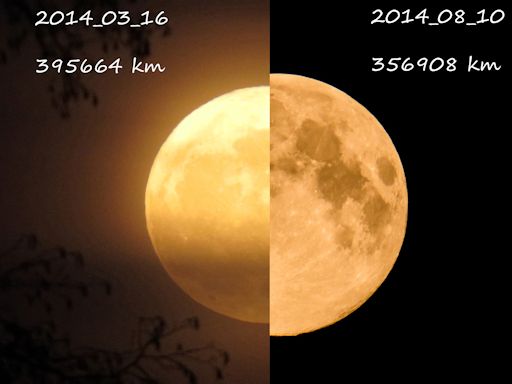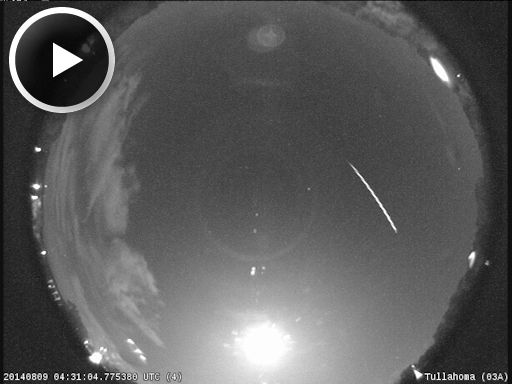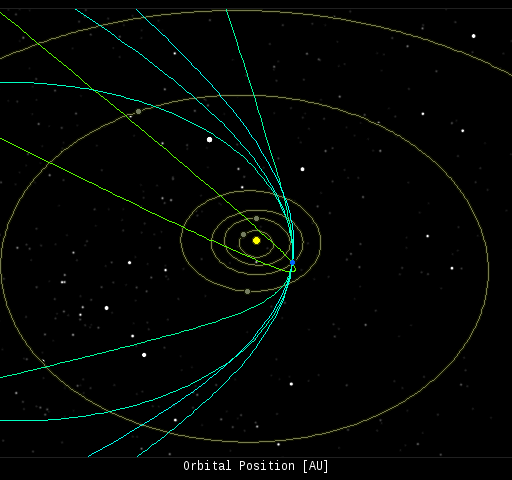When is the best time to see auroras? Where is the best place to go? And how do you photograph them? These questions and more are answered in a new book, Northern Lights - a Guide, by Pal Brekke & Fredrik Broms. | | |
MARS COMET WORKSHOP: On Oct. 19, 2014, Comet Siding Spring will pass so close to Mars that the atmosphere of the comet might interact with the atmosphere of the Red Planet. Today, researchers are gathering at the Johns Hopkins University Applied Physics Laboratory to discuss the encounter. The meeting will be streamed live starting at 8:45 AM EDT on Aug. 11th. Members of the public are welcome to listen and ask questions on Twitter using the hashtag #MarsComet.
WEEKEND SUPERMOON: The full Moon of August 10th was as much as 14% bigger and 30% brighter than other full Moons of the year. Some say that makes it a supermoon. Others retort that it's really not as super as the media has made it out to be. Who's correct? Vesa Vauhkonen of Rautalampi, Finland, took a stab at settling the question with this side-by-side comparison:

"I compared the normal full Moon of March 2014 with the Supermoon of Aug 2014," says Vauhkonen. "In individual images, the difference in size might be difficult to see, but putting them side by side makes the difference clear. I used the same photo settings for both images, so the scaling has no errors."
Supermoons are possible because the Moon's orbit is not a circle, it is an ellipse. One side, perigee, is 50,000 km closer than the other, apogee. On August 10th the Moon became full just as it reached perigee, the point closest to Earth. This caused the Moon to appear authentically bigger and brighter than usual.
More photos of the full Moon, and the landscape of Earth bathed in super-moonlight, may be found in the realtime photo gallery:
Realtime Space Weather Photo Gallery
PERSEID METEOR UPDATE The Perseid meteor shower is underway as Earth moves into the debris stream of parent comet Swift-Tuttle. According to the International Meteor Organization, the constellation Perseus is now spitting out meteors at a rate of about 20 per hour. In a normal year, those rates would increase 4- or 5-fold as the shower reaches its peak on August 12-13. But this is no normal year. In 2014, the glare of a supermoon will interfere with Perseid visibility, capping visible meteor rates at no more than ~30 per hour.
Now for the good news: The Perseids are rich in fireballs, and many of those extra-bright meteors can be seen in spite of the lunar glare. NASA cameras recorded one such fireball last night over Tennessee:

As the movie shows, the meteor cut through the moonlight wih ease. In the past week, NASA's network of all-sky cameras has recorded nearly 100 Perseid fireballs over the USA, and more are in the offing. So, note to sky watchers: Don't be put off by the supermoon. A trip to the moonlit countryside on August 12-13 will be rewarded by a display of Perseids, albeit fewer than usual.
A good time to look on those nights might be during the hours after sunset when the Moon is still hanging low in the sky and the constellation Perseus is rising in the northeast. Such an arrangement can produce a special type of meteor called an earthgrazer. Earthgrazers emerge from the horizon and skim the top of the atmosphere above the observer, a bit like a stone skipping across the surface of a pond. An hour's watching might net no more than one or two of this special kind of meteor, but that's plenty. Earthgrazers are colorful and gracefully slow, a rare beauty that makes any meteor-watch worthwhile.
Got clouds? You can listen to the Perseids live on Space Weather Radio.
Realtime Meteor Photo Gallery
Realtime Comet Photo Gallery
Realtime Aurora Photo Gallery
Realtime NLC Photo Gallery
Every night, a network of NASA all-sky cameras scans the skies above the United States for meteoritic fireballs. Automated software maintained by NASA's Meteoroid Environment Office calculates their orbits, velocity, penetration depth in Earth's atmosphere and many other characteristics. Daily results are presented here on Spaceweather.com.
On Aug. 11, 2014, the network reported 9 fireballs.
(6 sporadics, 3 Perseids)

In this diagram of the inner solar system, all of the fireball orbits intersect at a single point--Earth. The orbits are color-coded by velocity, from slow (red) to fast (blue). [Larger image] [movies]
Potentially Hazardous Asteroids (
PHAs) are space rocks larger than approximately 100m that can come closer to Earth than 0.05 AU. None of the known PHAs is on a collision course with our planet, although astronomers are finding
new ones all the time.
On August 11, 2014 there were potentially hazardous asteroids.
Notes: LD means "Lunar Distance." 1 LD = 384,401 km, the distance between Earth and the Moon. 1 LD also equals 0.00256 AU. MAG is the visual magnitude of the asteroid on the date of closest approach. | | The official U.S. government space weather bureau |
| | The first place to look for information about sundogs, pillars, rainbows and related phenomena. |
| | Researchers call it a "Hubble for the sun." SDO is the most advanced solar observatory ever. |
| | 3D views of the sun from NASA's Solar and Terrestrial Relations Observatory |
| | Realtime and archival images of the Sun from SOHO. |
| | from the NOAA Space Environment Center |
| | the underlying science of space weather |

